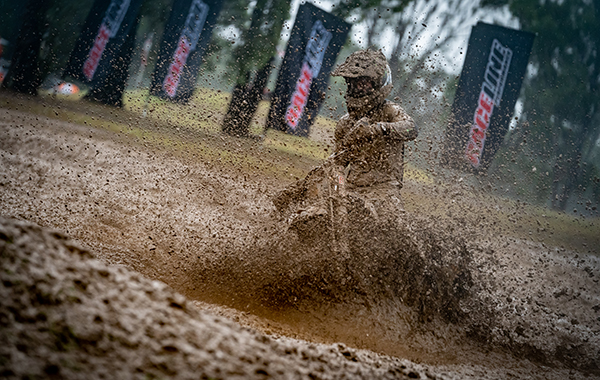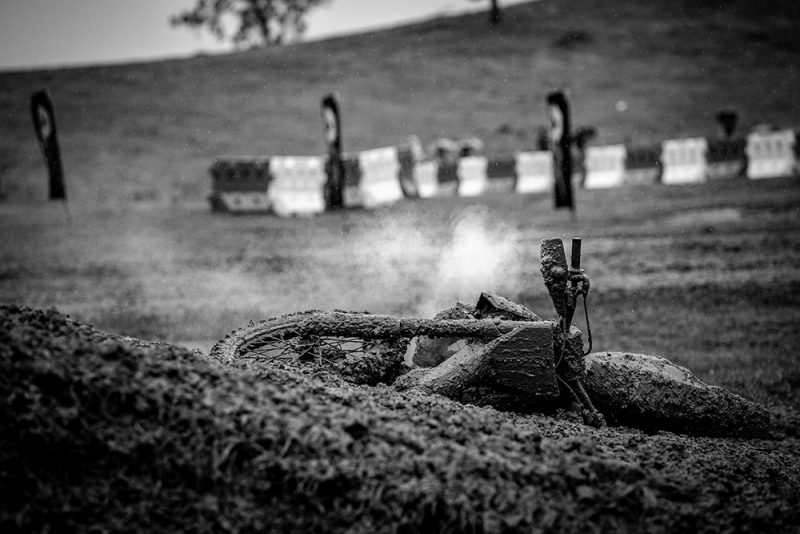
Mud can be the great equaliser. It can provide opportunity for the prepared, disaster for the not. Here are some tips and tricks to survive the mud.
STORY SHANE BOOTH PHOTOGRAPHY MATT BERNARD
When you arrive on race day and the weather hasn’t been kind, you need to prepare yourself, your gear and your bike for the day ahead. You need to look at the tough conditions and remember it’s the same for everyone. In many ways, you can remove all pressure and expectation from yourself and literally try to enjoy it. Most of all, stay positive — or you might as well load up, head home and save yourself a big clean-up.
KEEP YOUR HEAD IN THE GAME
So many riders throw in the towel when the skies open up — you can’t afford to do that if you want good results. Stay positive and focus on everything you can do to help make the day easier. Forget all the things you can’t control.
Preparation will make such a big difference in these conditions and it also keeps your mind busy and focused on things that are going to help you, which in turn will help keep you positive. Remind yourself it’s the same for everyone; if you’re struggling there’s a good chance everyone else is, too.
Remember to keep your head where your body’s at: don’t get ahead of yourself and don’t get hung up on anything that’s happened during previous races on the day.

GEAR PREPARATION
This is something that should start during the week and not so much on the morning of the race. Check the weather forecast to give yourself an idea of what you might be facing on race day. When it looks like there’s a good chance of a mudder, you can be ready.
Vision is the most critical factor in bad conditions so start by cleaning up every pair of goggles you own. In a perfect world, you’d have a fresh pair of goggles for every time you take to the track and a couple of extra pairs just in case. So, for example, if you have one practice session and three motos ideally, you’ll have six or seven pairs of goggles ready. The reason you want a fresh set for each time is that in horrible conditions it’s tough and time consuming to get goggles cleaned up between races. The few spare sets are just in case of a race restart or if you go through two sets in practice.
Once your goggles are clean, choose what type of vision-clearing setup you’re going to use and prep the goggles with them. If it’s tear-offs, load them up. The same goes for roll-offs: get the fresh film loaded and make sure they’re functioning. Once they’re all prepped, place each set inside a plastic zip-lock bag and seal it up; you can also mark on each pair what session they’re for. The zip-lock bag will keep them dry and clean right up to when you put them on for the start of the race.
You can also prep your helmet by adding an old goggle lens to the end of your helmet peak to extend it: this will help keep some of the rain and mud off your goggles. Some riders will tape foam to the top of their helmet to stop mud sticking and making their helmet heavy. You can tape up the mouthpiece to stop it from packing with mud and also help keep some of it out of your mouth. You can also tuck some rag into your nylons on each hip so if you do go down you can use it to wipe your hands and grips and continue with the race.
The last piece of advice is bring as much gear as you can to the race with you — a spare helmet and pair of boots can make for a much more comfortable race day. Also, when your gear is soaked with water it gets very heavy, so fresh gear is also lighter.

BIKE PREPARATION
Prepping your bike doesn’t need to be a major operation nor cost a fortune. When you prep for mud, the goal is to keep the bike as light as possible during the race and make sure it stays user friendly for the rider.
Coarse foam that doesn’t hold water works wonders in keeping mud from packing into every little space on the bike. Jam this stuff in just about anywhere it will fit: between the skid plate and the engine and around the brake pedal and gear shifter are the most popular places.
A pair of handguards works very well in the mud for keeping your hands and controls as clean as possible. Cover up your brakes with a clean rag and then coat under your fenders with a silicone spray; this will make it harder for mud to stick to your fenders. Some mechanics will tape up the airbox vents slightly to reduce their size, thus decreasing the chances of the bike sucking in water if it’s really wet. Your line selection is also important; to help avoid drowning your bike, stay away from large pools of standing water if you can.
You can add some preload to your rear shock to compensate for the extra weight you will have on the bike and also firm up the suspension slightly to help further. Between races, after washing your bike and changing the air cleaner, drain the carby bowl to be certain there’s no water in there and then run the bike for a minute or so to make sure there are no problems.
